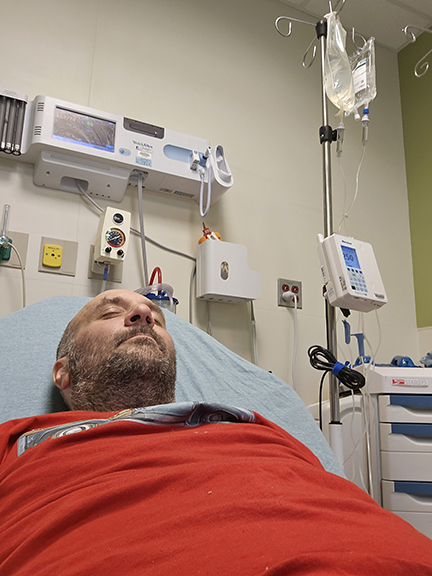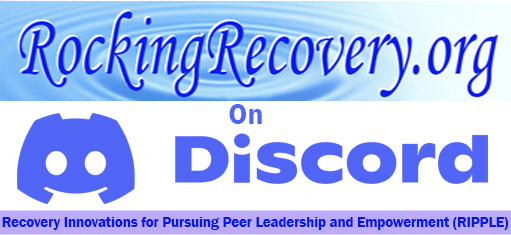Welcome to Ripple Reflections, our quarterly newsletter for everything going on at Recovery Innovations for Pursuing Peer Leadership and Empowerment and RockingRecovery.org. This page will host all the current information from this quarter. For all past additions you can visit the Newsletter Archive, all are available for PDF download and may be freely distributed to any party you believe would be interested or benefit from these publications. Thank you

Before we begin with our feature article we would like to explain the purpose and why it is being written at this time. RIPPLE’s Executive Director, Jeffrey Santo, was admitted to the hospital on March 28th, 2024 for issues related to diabetes. In a message to his friends and family. He described this ordeal as, “Life changing, not life ending. He is recovering and would like to share the observations he made along the way.
Jeffrey started telling his recovery story about 8 years ago, a short time later he became a Recovery Support Specialist and has since shared his story on countless occasions. His recovery story came from a part of his life nearly 20 years ago. A lot has happened since then.
Recovery Story, Chapter II: In the first week of March while cleaning up a piece of land Jeffrey’s foot became trapped between the branches of a fallen tree. He was finally able to free himself by pulling his foot out of his shoe. Taking a couple of steps, one shoe on and the other still off, he made his way over to a stump, sat down, and replaced his shoe. At that time it seemed to be nothing more than a slight annoyance. He then went back to work and completed the task at hand.

Two weeks later he began to experience what he described as a burning sensation on his calf, feeling as if it were a fairly bad sunburn. He ignored it and chalked it up to an insect bite even though there was no visible mark. Two weeks after that things took a very bad turn, his foot swelled, and it was clear at that point it was some kind of infection. He was taken to the emergency room of his local hospital and was quickly admitted when the scope of the damage became apparent. Without going into a detailed description the end result was the removal of one of his toes.
During his week in the hospital something became very clear, the difference between how he was treated when dealing with the medical staff versus how he was treated by the mental health staff in the same hospital a few years earlier.
Before Jeffrey was brought up to his room he spent several hours in the emergency room and had a meal there. It was a typical tray, the food was not half bad, and even though he had a loss of appetite from receiving the news about the severity of the infection, still managed to eat a little.
Page 1
In his room, after the surgery was over his tray was delivered for lunch. He was a little annoyed when he realized they had forgotten the flatware, no knife, fork, or spoon to be found. He told the nurse and she was able to locate him a spork. Still not having much of an appetite, the next meal he had asked for soup, a diet ginger ale, and a sugar-free lemon ice. He sipped the soup from the bowl and didn’t notice he had no spoon until it was time for dessert. He didn’t have dinner that night because he was scheduled for a procedure the next day that required fasting.
After he was brought back to his room the next afternoon, he ordered lunch and was very eager to eat. When his food arrived he again saw no flatware on the tray. He called the nurse and at this point, even the staff was annoyed with the kitchen. They called down there to see what was going on. About an hour later a “doctor” walked into his room and started asking him how he was feeling. Based on her questions and Jeffrey noticing that this person did not have a stethoscope around her neck, he knew this was someone from the psychiatric department fishing to see if he was experiencing suicidal ideations.
Even though it had been 5 years since he was hospitalized for depression, suicidal ideations, or any other mental health concern hospital safety protocols came online because of his history. One would think if they truly believed mental health is fluid, or even capable of changing over several years, they might have asked how he was feeling before trying to save him from himself.

The observation he made…
Medical Emergency: Going into the ER he was not asked to put on a gown, that happened once he got to a privet room. He was allowed to keep his cell phone, wallet, and other belongings.
Mental Health Emergency: Going into the ER he was ordered to put on a gown, and had his possessions taken away.
Medical Emergency: He was scared, shaking, and on the verge of tears. They waited for him to calm down before asking him to do a blood draw and to have an IV put in his arm. Everyone was friendly and tried to reassure him that everything was going to be okay.
Mental Health Emergency: He was told they would be doing a blood draw, when he refused, they threatened him with security. When he refused to provide a urine sample they threatened to use a catheter. Even though he was speaking calm and advocating for himself they seemed to want to rush through the motions just to get him to the psychiatric unit. Everyone was rude, one nurse even went as far as saying, “I don’t have time for your shit” after he declined to have his vitals taken.
Admitted to the hospital for a Medical Emergency: After being taken to a room several nurses and doctors came to see him. They explained everything in detail, what they wanted to do and how they thought it would be best to move forward. He felt like he was part of his treatment team.
Page 2
Admitted to the hospital for a Mental Health Emergency: Once he arrived on the floor a staff member went over the unit rules. He was also told that he needed to have his vitals taken throughout the day as per hospital policy. He was never asked about personal preferences or what he was comfortable with, to him it felt like his treatment team was in charge and he didn’t have a say in anything meaningful.
Making choices in a Medical Situation: At one point post surgery, Jeffrey was asked if he would consider taking a medication to help resolve an issue, without getting too graphic let us just say it was to help his body regulate itself properly. He opted out and suggested trying to correct the problem using a dietary solution and if it did not resolve itself over the next two days he would take the medication. The nurse respected his choice and kept tabs ensuring the issue did not become a larger problem.
Making choices in a Mental Health Situation: In less than 12 hours of being admitted to the psychiatric department, Jeffrey was called up to the nurse’s window during the time they distributed medications to the patients. He was handed a cup of water and a small clear plastic container containing three pills, all different, and ordered with no explanation whatsoever. When he asked what they were and what they were supposed to do, the answers he got back were extremely vague. Jeffrey opted not to take the medication, for the rest of his stay he was referred to as non-compliant.
These experiences happened within two visits to the SAME hospital. The differences in the quality of care and consideration of the emotional state of their patient were night and day. We talk about the importance of mental health parity but for the most part, it is only about access to care and insurance coverage. We need to see that the quality of care, the amount of empathy a person receives, and the overall experience of hospitalizations are positive ones. So many people talk about the bad experiences they have had at the hands of psychiatric units all over our state, and a lot of those people stop seeking the services those hospitals provide.
With over 50,000 people lost to suicide, more than 1.6 million suicide attempts, and over 12.3 million people having serious thoughts of suicide in 2023, shouldn’t hospitals be working harder against alienating those who truly need help?

Our server officially launched on January 1st, 2024. We have started it off with a couple of threads including areas for offering suggestions for its improvement. The server can connect with others through voice chat as well and we are looking forward to exploring more of what Discord can offer our community. We will grow the server as needed adding rooms and chat channels as we grow.

Please contact RockingRecovery.org@gmail.com to request the link, we look forward to seeing you there.
Page 3
A note from Jeffrey:
I would like to thank my friends and family who supported me through this ordeal.
To my family, my mother and Joe especially, thank you both for seeing me through this stressful time. You were always there and helped me keep my head in a good place, talking about the future and what awaited me beyond that hospital bed.
To Desiree and Ava who literally dragged me to the hospital when I was too scared to walk through those doors on my own. They likely saved my life in the process.
To Emma, Jennifer, and Sha’ron at Advocacy Unlimited for keeping tabs on me, checking in, and registering me for the RSS retreat in May to make sure I had a spot secured… and a very special shout out to Michaela, whose breath exorcises enabled me to regain control over my emotions and find calm. Kept relaxed during all the blood draws helped keep my mind at ease.
To Jordan and Quinn at KTP, and other members of our Peer Respite Workgroup for cheering me up during the one meeting I was able to attend from my hospital bed.
To the wonderful folks at Toivo, I was able to access so much content from your YouTube channel, from the sound healing sessions with Sera to guided meditations with Heidi. It got me through some very hard moments and allowed me to shift my thoughts toward the positive.

Words can do little to describe not only my gratitude but also how lucky I am to have these amazing friends and family members in my life. I am truly blessed to have each and every one of you working with me, supporting me, and for most of all, having faith in me. The road ahead won’t be easy but the most meaningful journies rarely are.
The one thing that took me a long time to learn is that our hardest times in life can turn into experiences that you can use to help others.
Every dark day can be used to build a bridge and connect to someone who is struggling. I don’t believe in the idea that “God never gives us more than we can handle.” Instead, I believe that he gives us things we can not handle on our own. Learning to ask for help is a life lesson for many of us and for some, it can take a lifetime to understand that asking for help is okay. I am not afraid of the dark days ahead, for in those shadows a light shines brightly on the people who are meant to be part of my journey.
If tomorrow someone made me an offer, If I were to relive the worst day of my life over again, but at the end of it I would have someone else in my life like the people listed above as a reward, I would do it in a heartbeat. Thank you all for walking this rocky path of life and for sharing your many gifts with me and the rest of the world.

Page 4


